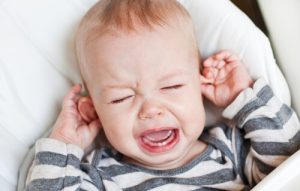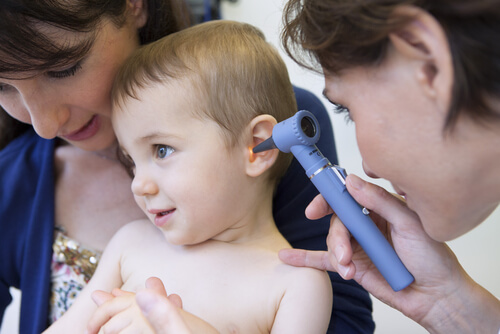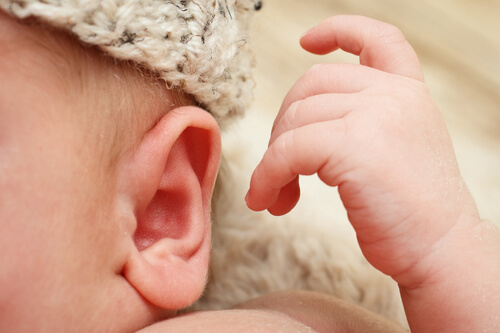Ear Infections in Babies: Symptoms and Treatment

Ear infections in adults and children are easy to treat with a good antibiotic. But what about ear infections in babies? Obviously in these cases the problem becomes more complicated.
Both diagnosis and treatment are very different for children from 0 to 36 months. The younger the child, the more difficult the condition is to treat.
However, below we’ll lay out the correct way to identify and treat ear infections in babies.
How to identify ear infections in babies
When a child has an ear infection, they simply point out the ear that hurts and tell their parents what happened. However, a baby can’t communicate verbally and therefore simply cries when anything hurts.
At this point the parents should try to find out what could be bothering their child. It’s not an easy task, so it’s useful to know that ear infections are very common in young children, and are most common in the summer.
If you suspect the ear is the source of the pain, one option is to gently press the child’s ear. If they cry more when you apply this pressure, you’re probably looking at an ear infection.
What not to do
If the child is very young, and you suspect they have an ear infection, you should take your child to the pediatrician. Only a doctor can make a confirmed diagnosis that will allow you to start treatment.

You should be aware that self-medication is very dangerous in babies from 0 to 3 years old.
Therefore you shouldn’t administer an antibiotic yourself without a prescription and a doctor’s authorization. Doing so could put your baby’s life in danger.
Ear infections are a very common recurrent illness for children. Keep in mind that acting negligently can lead to problems later on.
Treating ear infections in babies
In general, ear infections in babies under 2 years old are treated with antibiotics and gentle anti-inflammatory medication.
Of course, everything depends on the baby’s medical history, which is why a doctor’s opinion is so important.
The antibiotics and anti-inflammatories used most commonly come in drops. For the pain, most doctors prescribe commercial analgesics like paracetamol and ibuprofen in doses adapted for children.
You should also be aware that ibuprofen isn’t recommended for children under 6. Besides these analgesics, there are also other ways you can care for your child if they have this illness to improve their situation.
Creating conditions to treat an ear infection
One thing many doctors recommend is to not feed the child allergenic and lactose-based foods during the illness.
Drying your baby’s ears well at bath time is very important for preventing ear infections. It’s also important to dry them once the infection has started so as not to irritate them.
But in addition to water, extremely dry environments can create more pain and irritation in the affected area.
Some experts recommend using hot water bottles on the affected ear to alleviate the pain.

How can you tell if the infection has complications?
If the child has secretions, dizziness, vomiting, or fever above 38 degrees C, it’s important that parents bring their child to the pediatrician or to the Emergency Room.
Remember that it’s vital to control fevers in young children.
You should also act quickly if your child can’t walk correctly, has poor balance, or has a stiff neck. A medical checkup is vital for these symptoms.
If your child doesn’t improve with treatment after 48 hours, it’s a good idea to go back to the doctor who treated them.
Some facts about baby ear infections
According to the Spanish Society of Otolaryngology and Head and Neck Surgery, at least half of all Spanish children suffer from an ear infection in the first year of life.
In fact, ear infections are more common in children than adults. Today we know that premature children and those with a genetic predisposition are more susceptible to these infections.
In summary, ear infections are a treatable, recurrent illness which almost never lead to further problems.
However, certain complications can occur if parents don’t act appropriately and prudently.
Ear infections in adults and children are easy to treat with a good antibiotic. But what about ear infections in babies? Obviously in these cases the problem becomes more complicated.
Both diagnosis and treatment are very different for children from 0 to 36 months. The younger the child, the more difficult the condition is to treat.
However, below we’ll lay out the correct way to identify and treat ear infections in babies.
How to identify ear infections in babies
When a child has an ear infection, they simply point out the ear that hurts and tell their parents what happened. However, a baby can’t communicate verbally and therefore simply cries when anything hurts.
At this point the parents should try to find out what could be bothering their child. It’s not an easy task, so it’s useful to know that ear infections are very common in young children, and are most common in the summer.
If you suspect the ear is the source of the pain, one option is to gently press the child’s ear. If they cry more when you apply this pressure, you’re probably looking at an ear infection.
What not to do
If the child is very young, and you suspect they have an ear infection, you should take your child to the pediatrician. Only a doctor can make a confirmed diagnosis that will allow you to start treatment.

You should be aware that self-medication is very dangerous in babies from 0 to 3 years old.
Therefore you shouldn’t administer an antibiotic yourself without a prescription and a doctor’s authorization. Doing so could put your baby’s life in danger.
Ear infections are a very common recurrent illness for children. Keep in mind that acting negligently can lead to problems later on.
Treating ear infections in babies
In general, ear infections in babies under 2 years old are treated with antibiotics and gentle anti-inflammatory medication.
Of course, everything depends on the baby’s medical history, which is why a doctor’s opinion is so important.
The antibiotics and anti-inflammatories used most commonly come in drops. For the pain, most doctors prescribe commercial analgesics like paracetamol and ibuprofen in doses adapted for children.
You should also be aware that ibuprofen isn’t recommended for children under 6. Besides these analgesics, there are also other ways you can care for your child if they have this illness to improve their situation.
Creating conditions to treat an ear infection
One thing many doctors recommend is to not feed the child allergenic and lactose-based foods during the illness.
Drying your baby’s ears well at bath time is very important for preventing ear infections. It’s also important to dry them once the infection has started so as not to irritate them.
But in addition to water, extremely dry environments can create more pain and irritation in the affected area.
Some experts recommend using hot water bottles on the affected ear to alleviate the pain.

How can you tell if the infection has complications?
If the child has secretions, dizziness, vomiting, or fever above 38 degrees C, it’s important that parents bring their child to the pediatrician or to the Emergency Room.
Remember that it’s vital to control fevers in young children.
You should also act quickly if your child can’t walk correctly, has poor balance, or has a stiff neck. A medical checkup is vital for these symptoms.
If your child doesn’t improve with treatment after 48 hours, it’s a good idea to go back to the doctor who treated them.
Some facts about baby ear infections
According to the Spanish Society of Otolaryngology and Head and Neck Surgery, at least half of all Spanish children suffer from an ear infection in the first year of life.
In fact, ear infections are more common in children than adults. Today we know that premature children and those with a genetic predisposition are more susceptible to these infections.
In summary, ear infections are a treatable, recurrent illness which almost never lead to further problems.
However, certain complications can occur if parents don’t act appropriately and prudently.
All cited sources were thoroughly reviewed by our team to ensure their quality, reliability, currency, and validity. The bibliography of this article was considered reliable and of academic or scientific accuracy.
- Hijano Bandera, F; Monterrozas E. Otitis media aguda. An Pediatría Asoc Española Pediatría. 2003;1(1):1-80.
- Infecciones del oído en los niños. Hoja de información del NIDCD | Audición y equilibrio. [En línea].
This text is provided for informational purposes only and does not replace consultation with a professional. If in doubt, consult your specialist.








